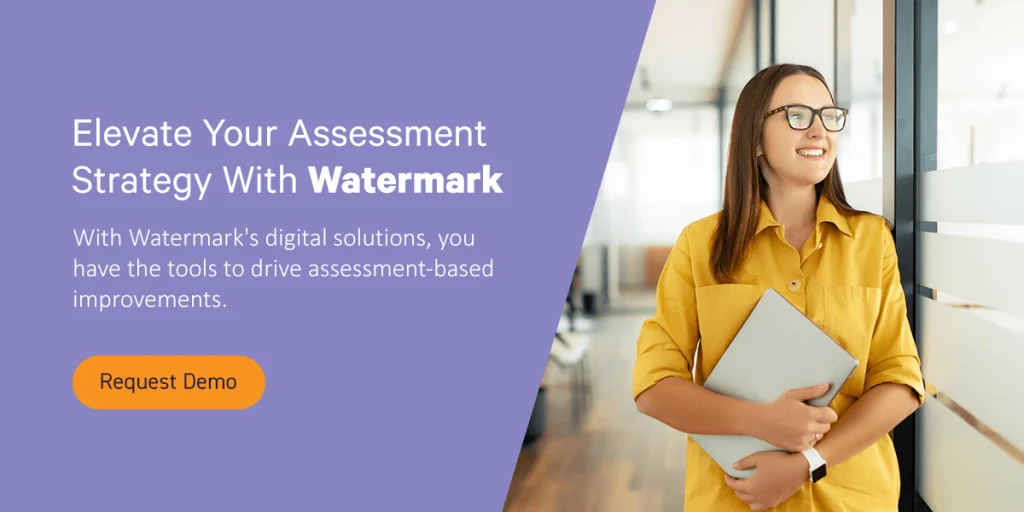




The importance of assessment in education has always been evident. However, the term itself has come to encompass a much broader and more detailed process in recent years. Aside from the traditional focus on what students can remember, assessment has taken on additional meaning thanks to innovative technology. Institutions can use assessment data to inform strategic decision-making, upgrade their curricula, and elevate the student learning experience.
The current assessment trends speak to this fundamental shift. They bring elements like different types of assessment, a focus on processes and experiences, and embracing technological innovations such as artificial intelligence (AI) to create a more detailed and accurate picture of how institutions are meeting their objectives.
Assessment in higher education has many meanings, but at its core, it measures what students know and what they can do. The process involves collecting information that measures the success of a course, program, or curriculum based on whether students have acquired the skills and knowledge associated with that program. It’s more than testing student competency and involves measuring an institution’s process toward its predetermined goals.
The assessment process is twofold — measuring student outcomes and an institution’s ability to provide students with the skills and knowledge they need to start meaningful careers. In return for holding students to a high standard, institutions receive actionable data to inform future improvements. While detailed and complex, innovative assessment processes can lead to improved results for students, faculty, and institutions as they tackle their relative opportunities for improvement with a firm overview of where to start and what steps to take.
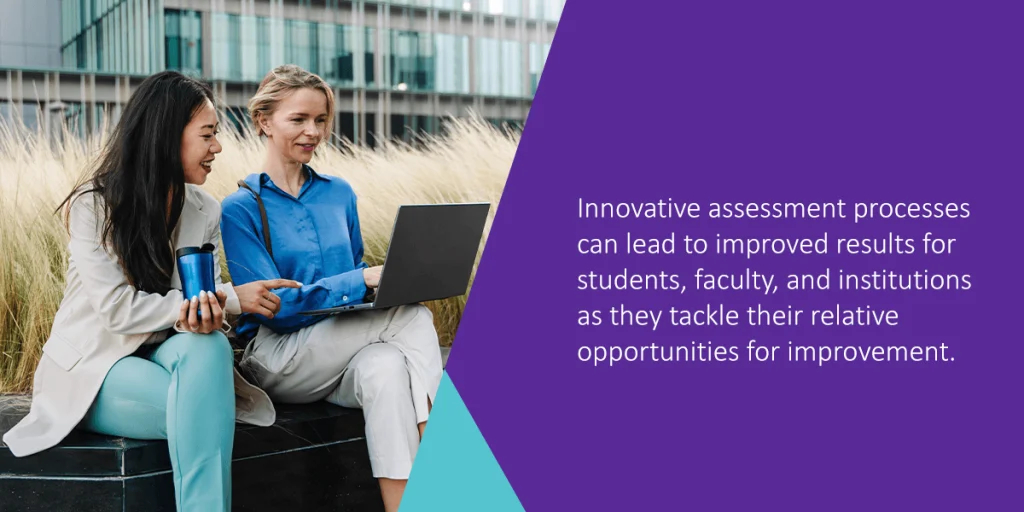
The importance of assessment goes beyond knowing what students have learned. Instead, it provides evidence of whether institutions and faculty members meet their objectives. In short, we assess to gain a holistic view of performance at all levels of an institution, from students to administration and leadership.
Although assessment serves many purposes, it focuses on ensuring students get the best possible education. To achieve this goal, higher education institutions must adopt a clear and realistic view of their strengths and weaknesses backed by data.
Traditionally, assessment was designed to measure what students could recall. Now, we assess for a different and more complex reason. We want to know how well we have prepared students to excel in their lives. To do that, we need to measure the skills we provide, such as critical thinking. In addition, we must measure their engagement and satisfaction with their course material to ensure they benefit most from their studies.
This shift in the focus of assessment has resulted in the need for institutions to evolve their assessment strategies to measure student knowledge in realistic situations and the ability of institutions to provide them with those skills. Assessment and feedback can change teaching and learning processes, engage students and faculty, and provide institutions with the data they need to foster a culture of continuous improvement.
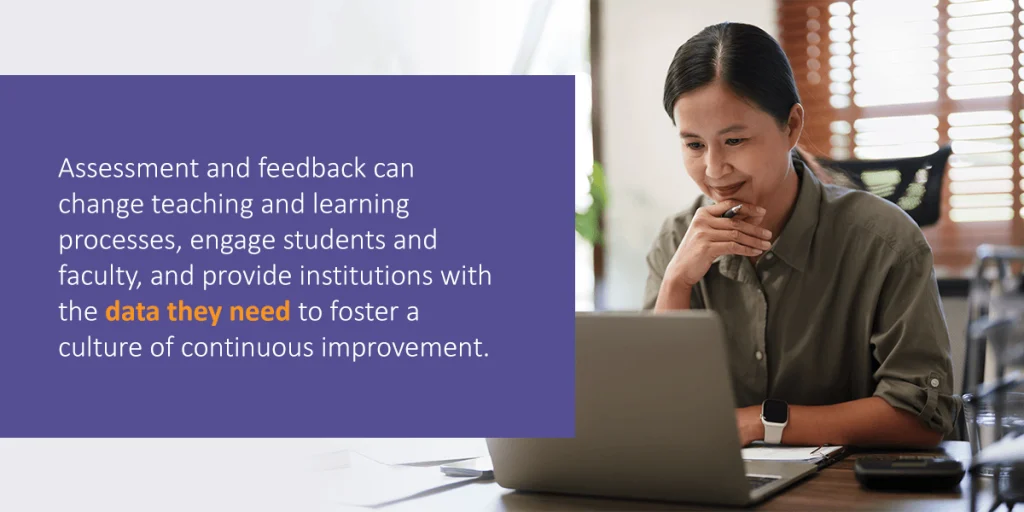
As institutions have realized the value of a more holistic approach to assessment, they have had to create and fine-tune more detailed assessment methods to measure various outcomes. Although some assessment methods are more illuminating than others, each serves a purpose in an institution’s mission to give students the highest possible value. Consider the types of assessments below.
Summative assessment has been the traditional assessment model in education for decades. It’s primarily learning outcomes-based and takes place at the end of a period of study. Summative assessment includes examinations and final papers. While it’s a helpful method of providing institutions with information on student achievement patterns, it allows for no improvement during a course. Access to assessment information during a course will enable educators to modify their teaching strategies and encourage students to reflect and demonstrate growth in certain areas.
Formative assessment is the consistent evaluation of student learning and aims to enhance student learning during the learning process. Innovative technology gives higher education institutions access to this data in real-time, making it a more accessible form of measuring student learning than ever before. Assessing student performance through this model allows educators to engage with them more meaningfully, encouraging them to understand their strengths and weaknesses and tailor the remainder of their learning accordingly.
In addition to providing students with a more focused and engaged learning experience, formative assessments give faculty members real-time information on the effectiveness of their teaching strategies. They, too, can identify opportunities for improvement and enrich the learning experience during the program itself.
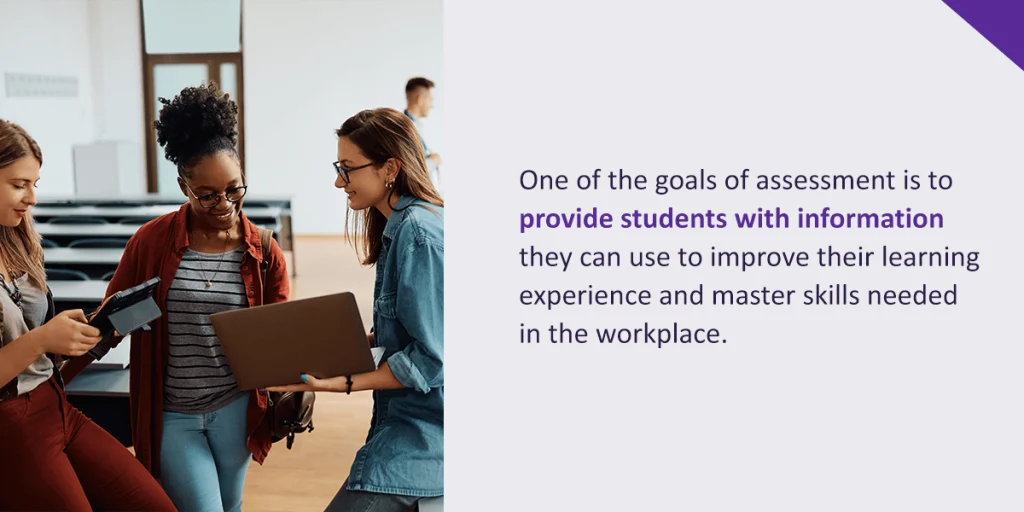
One of the goals of assessment is to provide students with information they can use to improve their learning experience and master skills needed in the workplace. Self-assessment empowers students to develop their judgment by assessing the process and product of their learning. It facilitates a sense of student ownership over their learning, leading to increased engagement, critical thinking, problem-solving, and leadership skills.
Using student assessment data to improve learning outcomes and teaching processes is an institutional form of self-assessment. Higher education institutions commit to their students to provide the best educational experience, and self-assessment is a powerful tool to turn student learning data into actionable improvements on an institutional level.
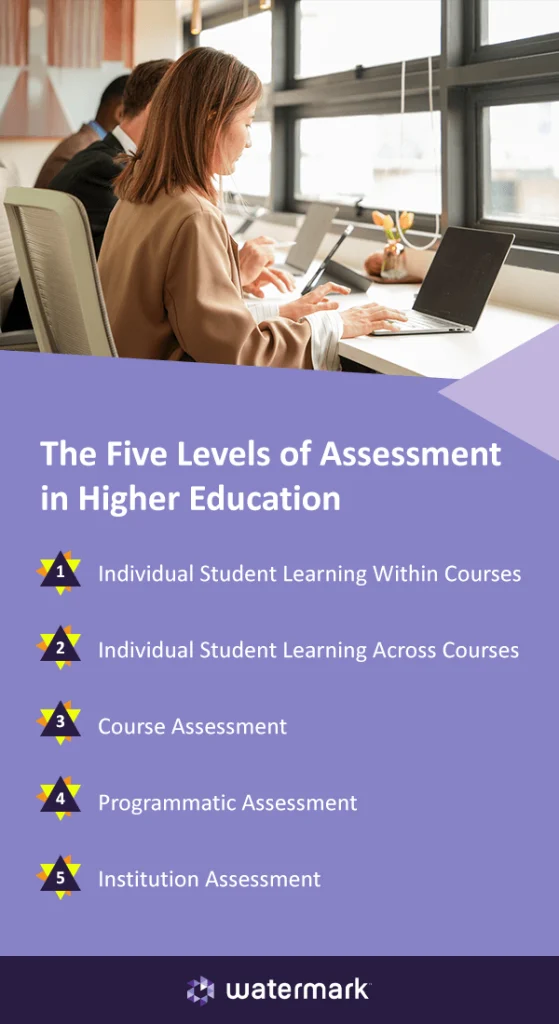
For institutions to realize the total value of assessment, it must occur on every level. Using a framework of five levels helps institutions pinpoint more specific improvement areas and focus their efforts. The five principal levels of assessment in higher education include:
This level aims to measure learning as the student progresses through a course. The chosen assessment tools should provide student strengths and weaknesses data and guide course development with actionable improvement recommendations.
A combination of formative and summative assessments yields excellent results on this level. However, institutions should deemphasize grades and look to more effective methods of providing the actionable feedback needed to strengthen student engagement and overall development. A focus on formative assessment allows administrators and faculty to evaluate a course while it is in progress — a powerful tool in a culture of ongoing improvement.
The second level of assessment aims to measure student development as they move through their specific program. It provides students with evidence of their growth across sources and gives them access to actionable feedback they can use to address their personal improvement areas.
Simultaneously, institutions have insight into how students perform against the program’s learning objectives. The data gathered at this level supports efforts to address gaps in student development, improving overall educational quality.
In the third level of assessment, institutions can start taking a broader view of their performance by evaluating the effectiveness of courses in helping students meet learning objectives, lay the groundwork for future areas of study, and obtain the skills and knowledge expected of their learning level.
Institutions can use various assessment tools to gather this information, including formative and summative assessment methods, as well as high-impact practices designed to boost career readiness in real-world situations. The data gathered at this level helps institutions identify areas of the curriculum that represent opportunities to improve educational relevance, meeting students where they are and gaining a broad view of where the course fits into the bigger picture.
The goal of the fourth level of assessment is to measure the relationship between curriculum strategy and learning objectives. Assessments on a programmatic level provide valuable information on how successfully a program prepares students to meet learning objectives. In addition, it reveals further curriculum gaps that may only be apparent with a broader view of the program.
Programmatic assessment relies primarily on summative assessments, establishing whether a program contributes to its predefined outcomes, fulfills its purpose, and advances institutional goals. It also confirms whether courses flow coherently and in such a way that supports cumulative learning, allowing students to progress from one level to the next with confidence.
As the name suggests, institution assessment measures how well institutions meet their goal of educating students and readying them for future assessments. Institutions can use the results gathered at this level to support curriculum design improvements and improve education quality at all levels.
People at every level of an institution are responsible for assessment at this level, and collaboration is essential to establish a culture of assessment and continuous improvement, backed by systematic and data-driven processes. These processes also allow institutions to look at issues like student engagement, retention, and enrollment with fresh eyes and determine new approaches to strengthen these areas in the post-COVID-19 landscape.
Assessment directly impacts the quality of the learning environment through prioritizing skills like reflection, reasoning, and critical thinking. The chosen curriculum and the types of assignments faculty provide students determine how they will approach learning, what behaviors they use, and ultimately, what they gain from taking part.
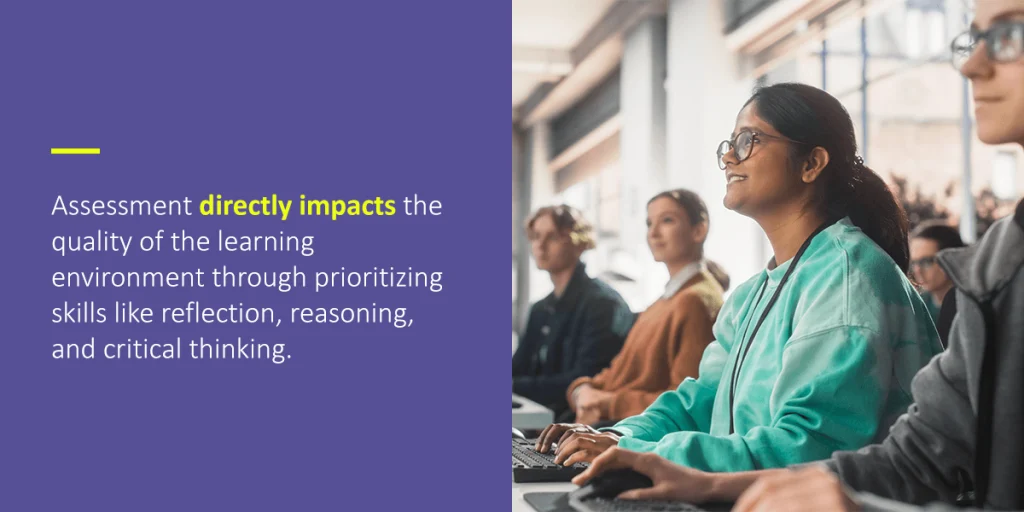
“Assessment for learning” is an essential distinction, augmenting “assessment of learning,” and shifting the focus from the past to the present tense. Instead of asking what students learned, institutions focus on where students are in their current learning, the nature of their understanding, any challenges they face, and how to help them move forward.
Assessment integrates into the learning process, instead of happening afterward. Instead of measuring what students have learned, assessment becomes a method of understanding student learning. The better we know it, the more we can support student success.
Assessment has the potential to be a catalyst for institution-wide change. However, it’s vital to remember that its primary purpose is to serve student success. The importance of assessment in the classroom is evident — it empowers students to take responsibility for their learning, engage with their course material, and take active steps to self-assess, improve, and make the most of their academic journey.
As assessment is tightly linked to instruction and curricula, it forms a framework in which faculty and students can work together toward achieving learning outcomes. Assessment informs instructions and guides students in taking their next steps. In a classroom setting, an appropriate assessment framework also gives faculty members the tools they need to engage individual students and work with them to achieve the course objectives.
While it is clear that assessment can power an institution’s approach to improving student learning, it has broader-reaching implications. Institutional goals encompass more than educating students, covering areas such as identifying at-risk students and getting them back on track, engaging them and meeting them where they are, and supporting student enrollment and retention.
Assessment data provides institutions with actionable insights on how well students are achieving an institution’s educational goals. Institutions can use this data to foster a culture of accountability, promote diversity, and assure curriculum quality. In addition, they can inform future strategies and use artificial intelligence (AI) to predict trends and remain agile in the ever-changing landscape of higher education.
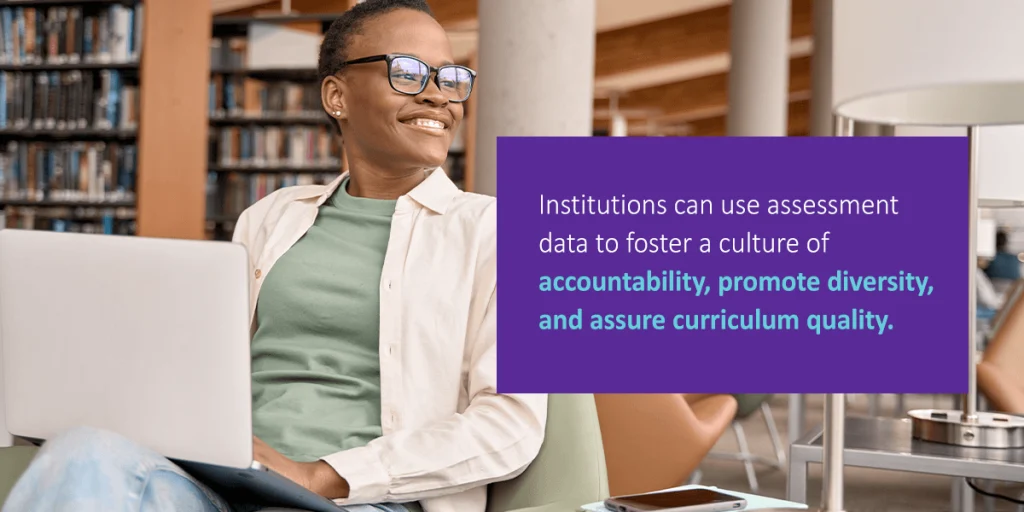
Practical assessment yields massive amounts of data, which is only helpful if you can leverage it to drive improvement and enhance the student experience. While this process can be complex, innovative and user-friendly technology makes data more manageable. However, to get the most valuable insights from assessment data, you must revisit the fundamentals of assessment and create a detailed roadmap of your measurement and reporting processes.
Every institution has an overarching goal, and assessment data can help you measure your progress toward these goals by tracking specific outcomes. For example, academic outcomes help track student development as they work their way through a course. Effective outcomes should be specific, measurable, achievable, realistic, and time-bound (SMART).
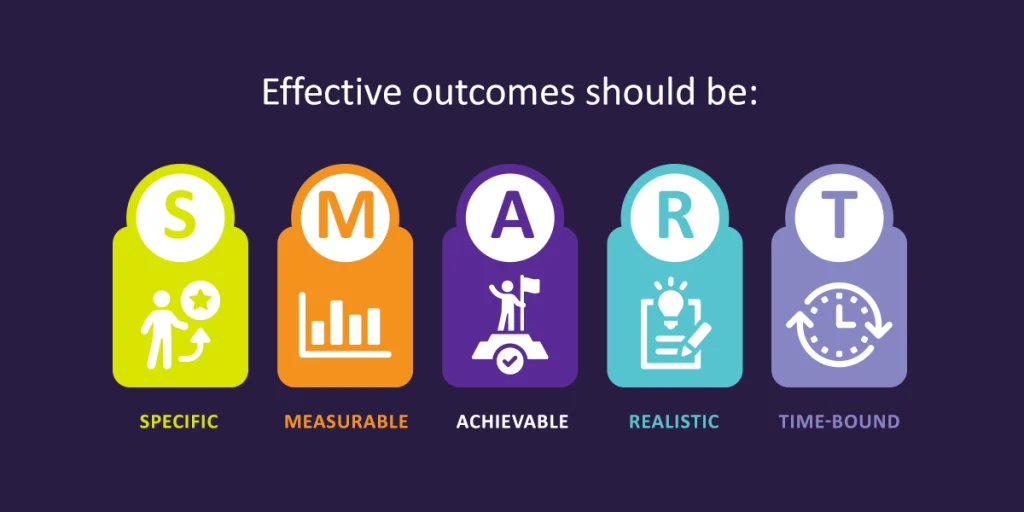
Every specific academic unit should have clear outcomes, which create the foundation for broader institutional goals. Tracking results based on assessment data is a powerful way to demonstrate your impact and measure progress. To measure the most critical elements of your framework, consider clarifying the following outcomes:
Curriculum mapping gives you insights into how your program meets specific outcomes. It shows the connections between the broader effects of a program and the courses where that learning is happening. A detailed curriculum map forms the foundation for your assessment process.
Curriculum mapping is a detailed process, but it helps your institution prioritize student development by planning a coherent sequence for courses and identifying teaching gaps. It improves your overall learning experience and provides evidence of how each course fits into the institution’s bigger picture. The following tips can streamline curriculum mapping efforts:
For every defined outcome, you must have a concept of measurement. Using direct and indirect measurements can help you get a more holistic view of your progress toward outcomes. Direct measurements include proof of student learning, like exams, essays, and capstone projects. Indirect measurements involve other signs of success, like student satisfaction surveys, attendance, and final grades.
Determine which type of measurement best suits each outcome and set a target on which to base your progress. Keep your goals in mind and make strategic changes when needed to support these goals.

For assessment in higher education to take on true meaning, you must do more than collect data and issue standardized reports. The data is there for you to drive continuous improvement throughout your institution. Take a close look at your data to take the appropriate steps. Keep the following tips in mind to make the most of your data-driven insights:
Assessment data should not exist in a file somewhere. Communicate your findings openly throughout your institution, and present your results in a way that encourages action at all levels. The assessment process is continuous and agile. Just as you evaluate assessment data, you must reevaluate the assessment process. Consider whether your outcomes are still appropriate and look for opportunities to collect data from different — and possibly more relevant — sources.
As your outcomes change, evaluate whether you’re collecting data at the right time, through the right mediums, and ensure it matches your intent. Determining what is working and what isn’t can be challenging. Still, it begins with creating a data-informed assessment culture, using the right digital assessment solution, and communicating often in a way that resonates with your stakeholders.
Higher education institutions exist to enrich the learning experience and prepare students for meaningful careers in their chosen fields. Student assessment data is a critical part of institutional improvement. Still, the insights inspire success and create a culture of continuous improvement. Having the right tools to access the insights you need to evolve is just as important as the assessment data itself. With Watermark’s digital solutions, you have the tools to drive assessment-based improvements.
Watermark Planning & Self-Study can streamline your assessment and accreditation reporting, allowing your institution to balance technology with students at the center. Combining innovative software solutions with your institutional outcomes and robust reporting capabilities can take assessment in higher education from theoretical to actionable. Request a demo today to learn more.
